 Facebook
Facebook
 X
X
 Instagram
Instagram
 TikTok
TikTok
 Youtube
Youtube

Alpine resident Gary Lane's niece and nephew talk of having their own high school in Alpine. All the kids do, said Lane. Keeping teen spirit local is the dream while the nightmare is that long and dangerous commute to high schools in the Grossmont Union High School District. Lane's niece and nephew commute to one of them, Granite Hills High.
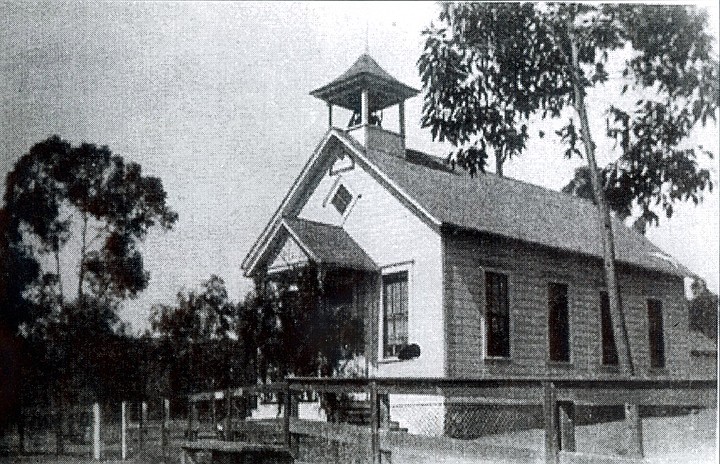
For decades, Alpine residents have been expecting a high school to come to their town at the foothills of the Cuyamaca Mountains. Alpine has a K–8 school district that directs high school students to the Grossmont high-school district; the latter has 11 schools spread out between El Cajon, La Mesa, Spring Valley, Santee, and Lakeside.
"Over the years, there have been accidents and several fatalities of both parents and students,” said Alpine resident Sal Casamassima. "Most recently, an Alpine student coming from Steele [Canyon High] was involved in a head-on collision with, coincidentally, one of the [Alpine School District] employees."
Casamassima's daughter won't be making that trek, as he has moved her to the Coronado school district. "Many other parents have made similar moves and there are numerous examples of families deciding not to move to Alpine or moving out of Alpine for lack of a high school."
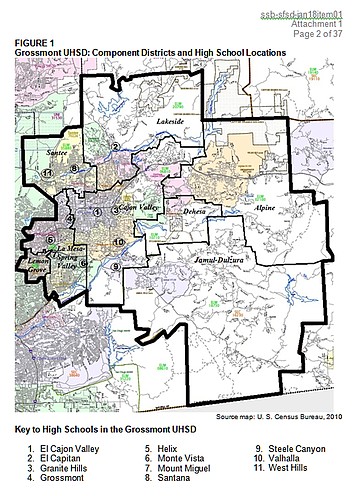
For 20 years, hopes have been repeatedly raised and dashed. In 1997, a planned Alpine high school was instead built in Spring Valley. Since that time, Alpine has attempted to reorganize their K-8 school district into a K-12 district (called “unification”). This would allow them to build their own high school.
The road to no high school in Alpine has been paved with good intentions. Funding was secured via millions in bond measures, a school site was purchased via eminent domain, and demolition begun. Everything halted circa 2012. A 2013 San Diego County Grand Jury report followed, as did a 2014 lawsuit and another stab at unification.
In January 2018, the state board of education denied Alpine's most recent attempt at unification and an appeals court upheld that Grossmont wasn't obligated to build the high school.
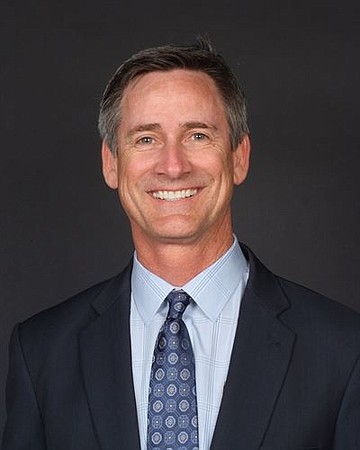
Scott Patterson, business services deputy superintendent, oversees the school bonds program at the Grossmont Union High School District. He said Alpine students enrolling into Grossmont schools have decreased slightly over the past five years. Patterson said 300 Alpine students attend Granite Hills and an estimate of 400 attend Steele Canyon in Spring Valley.
According to Patterson, when Proposition U passed in 2008, student enrollment was at 23,245. When numbers dipped to 22,200, work had to be halted. The bond measure dictated enrollment numbers of at least 23,245 to build the school. Numbers have declined to 21,000 per Patterson.
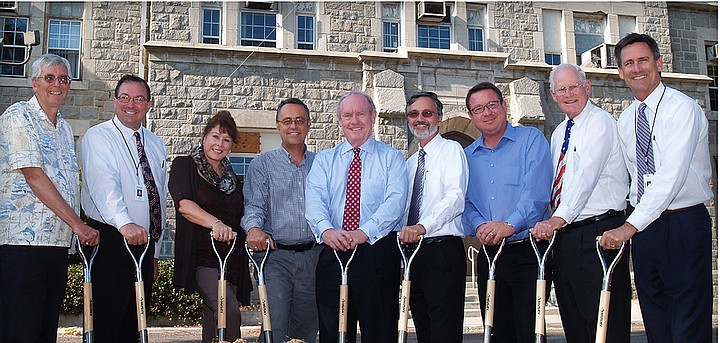
Casamassima said the decline in enrollment is due to schools like Cajon Valley where nearly 1000 students, mainly Chaldean immigrants, left the school to attend local charter schools.
Patterson said while they are working toward extending the life of construction permits for Alpine, in case enrollment numbers increase, "the district's governing board may elect to use [Prop U] funds to complete other near term high priority projects. Funds for the [Alpine] high school project would then come from future bond sales."
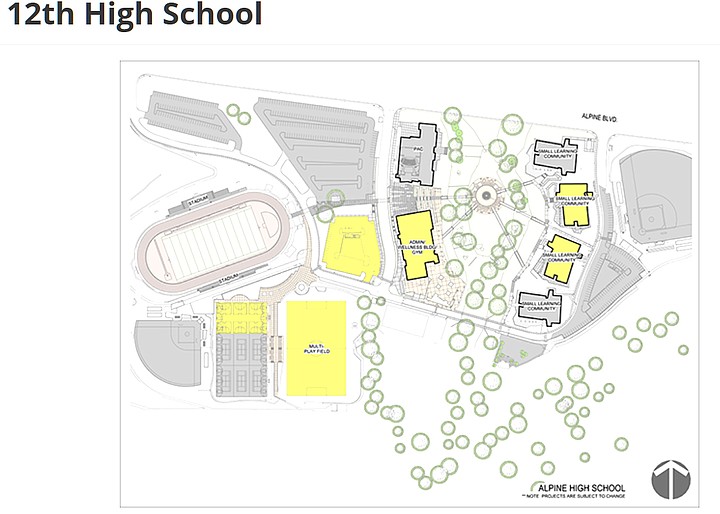
Besides enrollment and bond funds, Patterson pointed to the additional $1 million in overhead a new school would bring his district — one that has seen its share of financial woes.
George Barnett, a plaintiff in the recent lawsuit, called Grossmont's recent legal victory "a technical win with admonitions of a decade of poor behavior."
Barnett said the case for Prop U in 2008 ($417 million) was to complete the promises not kept in the 2004 Prop H ($274 million). The latter pointed to constructing the new high school but funds were gobbled up by other projects. Prop U specifically told voters a new high school in Alpine or nearby Blossom Valley was in the cards. Barnett said it looks now to be on the "list for 2035, 30 years after Alpiners began paying their share of $150 million in principal and interest."
In an ironic twist, money earmarked for a park the community has been waiting on for near two decades may go toward upgrading Alpine's middle-school athletic fields. Barnett said the upgrade would serve both the community and the school and shouldn't detract from the county's efforts to secure more parkland in Alpine.
Mary Harris said before the Alpine School District knew the outcome of their legal battle with Grossmont, "they energetically began to sell their idea to Alpine to vote for spending an undisclosed amount of money on a 9-acre sports complex at Joan MacQueen middle school."
Harris is part of a grassroots movement focused on a new park for her community. Every week, she sets up shop outside Ace Hardware or Albertsons to talk to people.
"It would be nice if we could get both a park and a high school, but that's not looking possible." Harris said while Grossmont is blamed for breaking a promise, maybe voters should have read the fine print. "Their promise came with conditions." She said the Alpine School District should take some of the blame for getting everyone's hopes up.


Alpine resident Gary Lane's niece and nephew talk of having their own high school in Alpine. All the kids do, said Lane. Keeping teen spirit local is the dream while the nightmare is that long and dangerous commute to high schools in the Grossmont Union High School District. Lane's niece and nephew commute to one of them, Granite Hills High.

For decades, Alpine residents have been expecting a high school to come to their town at the foothills of the Cuyamaca Mountains. Alpine has a K–8 school district that directs high school students to the Grossmont high-school district; the latter has 11 schools spread out between El Cajon, La Mesa, Spring Valley, Santee, and Lakeside.
"Over the years, there have been accidents and several fatalities of both parents and students,” said Alpine resident Sal Casamassima. "Most recently, an Alpine student coming from Steele [Canyon High] was involved in a head-on collision with, coincidentally, one of the [Alpine School District] employees."
Casamassima's daughter won't be making that trek, as he has moved her to the Coronado school district. "Many other parents have made similar moves and there are numerous examples of families deciding not to move to Alpine or moving out of Alpine for lack of a high school."

For 20 years, hopes have been repeatedly raised and dashed. In 1997, a planned Alpine high school was instead built in Spring Valley. Since that time, Alpine has attempted to reorganize their K-8 school district into a K-12 district (called “unification”). This would allow them to build their own high school.
The road to no high school in Alpine has been paved with good intentions. Funding was secured via millions in bond measures, a school site was purchased via eminent domain, and demolition begun. Everything halted circa 2012. A 2013 San Diego County Grand Jury report followed, as did a 2014 lawsuit and another stab at unification.
In January 2018, the state board of education denied Alpine's most recent attempt at unification and an appeals court upheld that Grossmont wasn't obligated to build the high school.

Scott Patterson, business services deputy superintendent, oversees the school bonds program at the Grossmont Union High School District. He said Alpine students enrolling into Grossmont schools have decreased slightly over the past five years. Patterson said 300 Alpine students attend Granite Hills and an estimate of 400 attend Steele Canyon in Spring Valley.
According to Patterson, when Proposition U passed in 2008, student enrollment was at 23,245. When numbers dipped to 22,200, work had to be halted. The bond measure dictated enrollment numbers of at least 23,245 to build the school. Numbers have declined to 21,000 per Patterson.

Casamassima said the decline in enrollment is due to schools like Cajon Valley where nearly 1000 students, mainly Chaldean immigrants, left the school to attend local charter schools.
Patterson said while they are working toward extending the life of construction permits for Alpine, in case enrollment numbers increase, "the district's governing board may elect to use [Prop U] funds to complete other near term high priority projects. Funds for the [Alpine] high school project would then come from future bond sales."

Besides enrollment and bond funds, Patterson pointed to the additional $1 million in overhead a new school would bring his district — one that has seen its share of financial woes.
George Barnett, a plaintiff in the recent lawsuit, called Grossmont's recent legal victory "a technical win with admonitions of a decade of poor behavior."
Barnett said the case for Prop U in 2008 ($417 million) was to complete the promises not kept in the 2004 Prop H ($274 million). The latter pointed to constructing the new high school but funds were gobbled up by other projects. Prop U specifically told voters a new high school in Alpine or nearby Blossom Valley was in the cards. Barnett said it looks now to be on the "list for 2035, 30 years after Alpiners began paying their share of $150 million in principal and interest."
In an ironic twist, money earmarked for a park the community has been waiting on for near two decades may go toward upgrading Alpine's middle-school athletic fields. Barnett said the upgrade would serve both the community and the school and shouldn't detract from the county's efforts to secure more parkland in Alpine.
Mary Harris said before the Alpine School District knew the outcome of their legal battle with Grossmont, "they energetically began to sell their idea to Alpine to vote for spending an undisclosed amount of money on a 9-acre sports complex at Joan MacQueen middle school."
Harris is part of a grassroots movement focused on a new park for her community. Every week, she sets up shop outside Ace Hardware or Albertsons to talk to people.
"It would be nice if we could get both a park and a high school, but that's not looking possible." Harris said while Grossmont is blamed for breaking a promise, maybe voters should have read the fine print. "Their promise came with conditions." She said the Alpine School District should take some of the blame for getting everyone's hopes up.
Comments